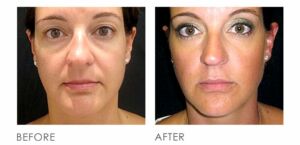Ultrasound therapy – commercially known as Ultherapy – improves the appearance of moderately loose or sagging skin by depositing focused ultrasound energy below the surface to stimulate the body’s creation of new collagen, the natural protein that gives skin its youthful firmness and elasticity. Skin begins to lift and tone over time.
Possible risks
As with any treatment, there are risks associated with it, though they are minimized in the hands of a qualified ASDS dermatologist. These include:
- Temporary slight redness.
- Mild and temporary swelling, tingling or tenderness to the touch.
Why choose ultrasound therapy for sagging skin
Ultrasound therapy is typically used on the brow, neck and under the chin. The treatment is non-surgical and can be performed in a doctor’s office.
What you should know about ultrasound therapy for sagging skin
The practitioner who performs the procedure will first cleanse your skin thoroughly. Next, an ultrasound gel is applied and the smooth handpiece is placed on your skin. The focused ultrasound energy is delivered to pre-planned depths within the tissue below the surface of your skin to stimulate collagen growth. Ultrasound therapy literally bypasses the surface of the skin, targeting the deep, structural skin tissues where collagen resides. The procedure uses the body’s own regenerative response to recondition the network of collagen fibers.
During the procedure, which can last up to 30 to 90 minutes depending on the treated areas, patients can experience sensations of varying discomfort levels while the ultrasound energy is being delivered. The sensations are noticeable only while the energy is being delivered.
What to expect after the procedure
Afterward, patients typically experience temporary flushed skin. Patients may also experience:
- Slight swelling for a few days.
- Mild and temporary tingling or tenderness to the touch for a few weeks.
- Temporary small areas of bruising or numbness.
Most patients only need one procedure, but some can benefit from more than one treatment depending on their biological response to the ultrasound and collagen-building process as well as how much laxity they have in their skin.
Patients can see some immediate effects but the ultimate lifting and toning takes place over the subsequent two to three months. Additional improvements can appear up to six months following the procedure. The effects of the treatment can last up to a year. Follow-up treatments can be performed.
How to prepare for the procedure
Before the procedure, an ASDS dermatologist will review the patient’s medical history. This is the time for the doctor and patient to discuss expectations, potential risks and outcomes of the procedure. Although no preparation is required before the procedure, your doctor may recommend that you take over-the-counter or prescribed pain medication prior to your session.

